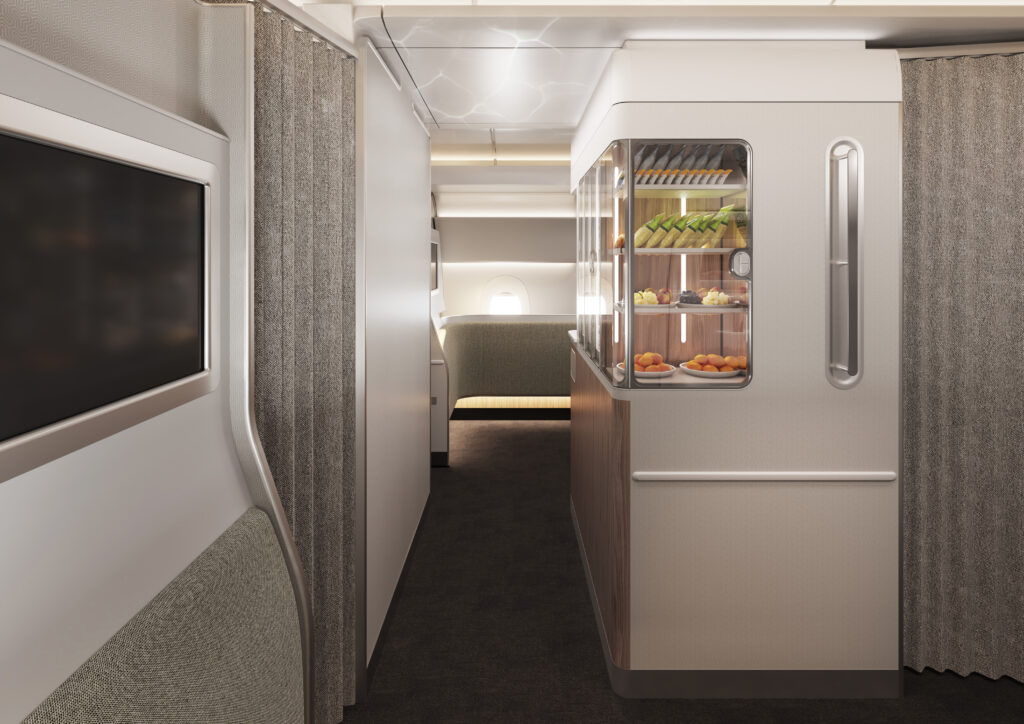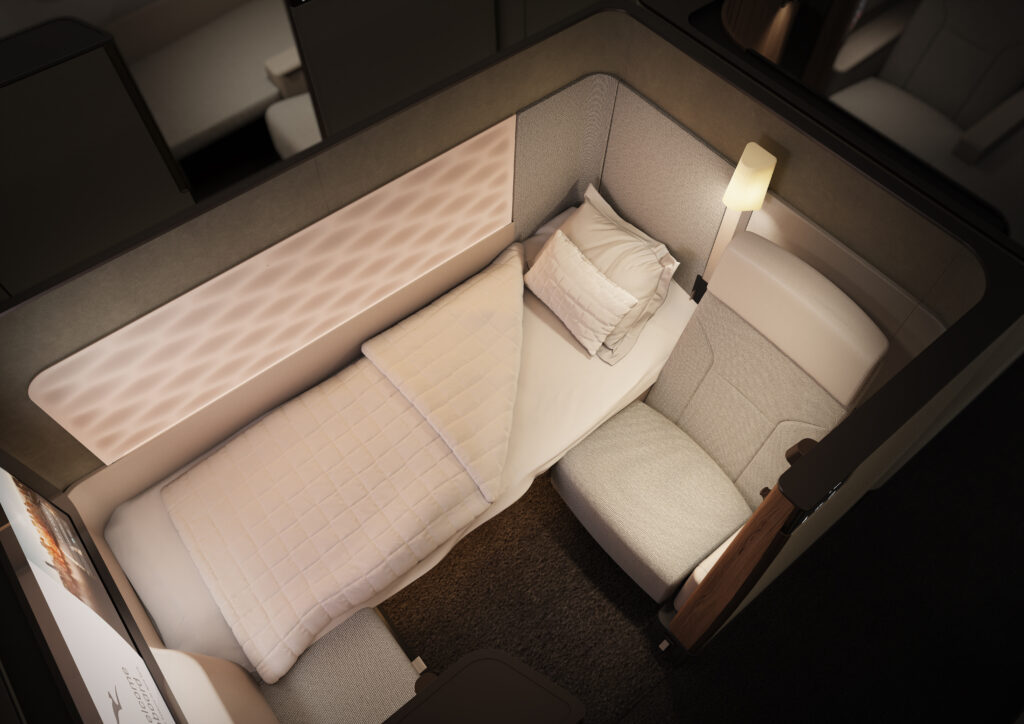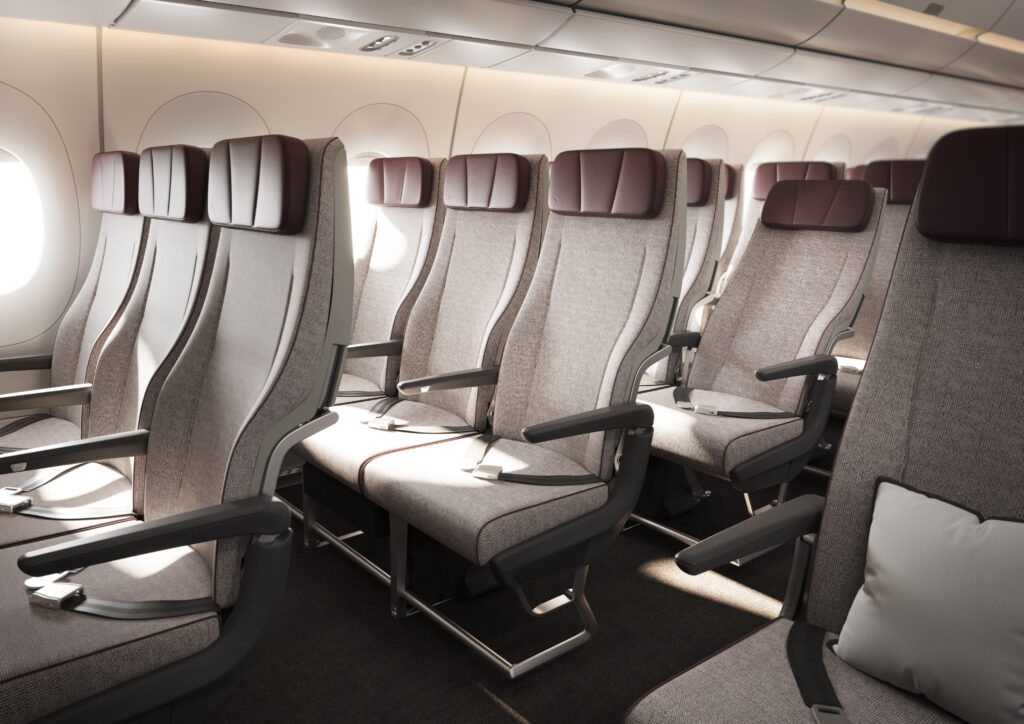Qantas Unveils World-First Wellbeing Zone For New York and London Direct Flights
Share
Qantas today showed us what the passenger experience will be like for anyone flying direct from Sydney to New York or London from late 2025.
This includes an area that Qantas says is a world-first – a Wellbeing Zone, located between the Premium Economy and Economy cabins of the A350 aircraft.

Called ‘Project Sunrise’, work on redesigning the cabin for ultra long-haul flights began in 2019. The end goal will be to fly 238 passengers for up to 22 hours non-stop in an A350 from Australia to almost any destination in the world, starting with New York and London.

The aircraft will have six large enclosed First Suites. According to Qantas, these are “designed to feel like a mini boutique hotel room with 2 metre flat bed, dining table for two, separate recliner chair and a 32” 4k ultra-high definition touch screen TV.”
The 52 Business Suites will feature sliding doors for additional privacy, lay flat bed, large dining table, bespoke lighting and 18” 4k ultra-high definition touch screen TV.
However, Qantas Group Chief Executive Officer Alan Joyce says that the airline recognises that most people on these ultra-long flights will be flying in the premium economy or economy cabins: “We have spent just as much time on the second half of the aircraft as we did the front.”

In Premium Economy, there will be 40 seats, which have been redesigned with new headrest wings to provide additional support and a sense of privacy. An upholstered ergonomic foot and leg rest system allows the body to be cradled in recline to help passengers sleep.

The Economy Cabin will have 140 seats. Here passengers will benefit from 33 inches of legroom, an OLED 13” TV screen, foot net and convenient storage space within arms’ reach to store glasses and personal items.
The Wellbeing Zone, sitting in between both cabins, will have sculpted wall panels and integrated stretch handles, guided on-screen exercise program, a hydration station and a range of refreshments.
CEO Alan Joyce says that the zone has been made possible, due to the a reduction in seats on the aircraft: “Reducing the number of seats onboard our A350 to 238 compared to the 300-plus seat layout of other carriers means we not only maximise aircraft performance across long distances, we give our passengers more space and comfort.
“Fewer seats translate to more space for each customer and a dedicated Wellbeing Zone for travellers to stretch, help themselves to a snack and spend time out of their seat. We are the only airline in the world that will have a bespoke designed onboard stretch and movement space.”
All four cabins will benefit from USB-C charging ports and fast, free WiFi as well as bluetooth connectivity so customers can connect their personal headsets to the individual inflight entertainment screen.
Research looks at how jet lag can be reduced
Qantas has also released findings on jetlag, following research that was carried out in collaboration with the University of Sydney’s Charles Perkins Centre.
Qantas says that different lighting and sleep schedules, mealtimes, and specific ingredients like chilli and chocolate during long-haul flights have been shown to contribute to improved traveller wellbeing. Movement and exercise are, unsurprisingly, a key element.
Researchers travelled on the aircraft and monitored 23 volunteer customers who were fitted with wearable device technology during the 20-hour flights as they followed a specially designed menu, lighting, sleep and movement sequences.
Initial findings, as yet unpublished, indicate that, compared to customers on a traditional inflight sequence of eating and sleeping, those on the tailored schedule experienced:
- less severe jet lag (self-reported)
- better sleep quality inflight
- better cognitive performance in the two days after flight
The inflight trials involved tailored cabin lighting schedules to facilitate adaptation to the destination time zone and integrating simple stretch and movement activities.
They also adjusted the timing of meal services to align the body clock and encouraged wake and sleep by using specific menu items including fish and chicken paired with fast-acting carbohydrates, as well as comfort foods like soups and milk-based desserts. The aim was to promote the brain’s production of the amino acid tryptophan (‘Tryp’) to help passengers drift off more easily.
Peter Cistulli, Professor of Sleep Medicine at the University of Sydney said while the research was ongoing, there were clear signs that the interventions implemented during the trial flights reduced the impact of ultra long-haul travel.
“The early results are promising, and it’s given us great momentum to look to the next stage of customer research to support Project Sunrise product and service design,” said Professor Cistulli.
Alan Joyce said the national carrier was excited by the prospect of minimising jet lag and revolutionising international flying for all travellers.
“Given our geography, Qantas has a long history of using imagination and innovation to overcome the tyranny of distance between Australia and the rest of the world,” said Mr Joyce.
“Now that we have the aircraft technology to do these flights, we want to make sure the customer experience evolves as well, and that’s why we’re doing this research and designing our cabins and service differently.”


